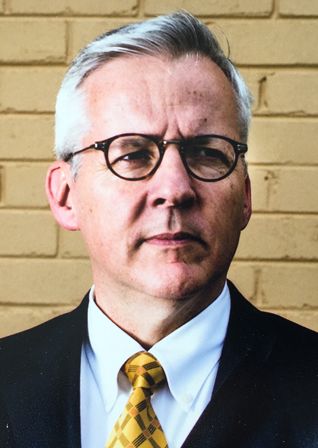"The Debate Papers" provides a platform for learned voices to argue issues affecting the United States and Australia. These counterpoints traverse topics such as economics, foreign policy and politics. If you’d like to contribute to the series, email brendan.thomas-noone@sydney.edu.au or jared.mondschein@sydney.edu.au.
Australia should maintain a military presence in the Middle East
Rodger Shanahan
When Professor John Blaxland and I swore our enlistment oath down near Central Station in Sydney in January 1983 — before getting on a bus for a trip to the Royal Military College Duntroon that would be our home for the next four years — the strategic environment was a much different place to that which it is today. The Cold War still dominated the international security space. Some of our instructors were Vietnam veterans and their world and operational military view was naturally shaped by that conflict. As far as the Middle East was concerned, its place in our military training was confined to the occasional military history presentation and the naming of two of the companies by which cadets were organised and accommodated: Romani and Alamein.
Military operations conducted by the Australian Defence Force (ADF) in that part of the world never featured as part of the strategic debate, even if we had small groups deployed in the Sinai and with the United Nations there at the time.1 Today, of course, it seems that we can’t keep out of the region. Land deployments to Iraq and Afghanistan, naval operations in the Persian Gulf, Arabian and Red Seas and air operations over Iraq and Syria are illustrative of the operational focus we maintain on the hitherto largely ignored region. And while the immediate requirement for some of our current missions in the region will likely cease in the coming months, the variety of contingencies that we have responded to in the past decade and a half may well be repeated in the future, along with other as yet unforeseen crises. The last thing we should be thinking of doing is packing up our tents and precipitously leaving the Middle East, thinking yet again that it is a temporary aberration in our traditional regional security policy.

After the ADF was given a 2014 exit date from Afghanistan for example, I argued for continued engagement in the Persian Gulf and noted that "it is very possible… that Australia will once again be called upon to deploy niche military and/or other government assets into the region to conduct evacuation, special recovery or military assistance missions".2 Four years after I stated this case, the ADF had two land Task Forces deployed in Iraq and RAAF aircraft operating over Iraq and Syria operating as part of a broad multi-national coalition against a radical Islamist organisation whose rise was as rapid as was the threat it posed to regional states and Western citizens.
The reality is that we can never foretell the future. As a middle power with global interests, a commitment to protecting our own nationals and the United States alliance, and to confronting the terrorist threat, we should acknowledge that those needs dictate an ongoing military presence in the Middle East. The tyranny of distance that has variously bedeviled and protected us is no longer as relevant as it used to be. An increasingly globalised world and a broader and more diverse immigration program have seen to that. The 2006 conflict between Israel and Lebanese Hezbollah for instance, would not have been of such political significance to Australia were it not for the tens of thousands of Australian passport holders who are present there at any one time. As it was, the largest overseas peacetime evacuation in Australian history occurred not in our region but in the Middle East. Approximately 5,300 Australian citizens and 1,300 foreign nationals were evacuated from Lebanon during the conduct of Operation Ramp. In the Persian Gulf the UAE alone is host to more than 20,000 Australian expatriates, and more than 300,000 Australian tourists annually. Regional security impacts directly on Australian citizens whether Australian strategic pundits like it or not.
The tyranny of distance from the Middle East that has variously bedeviled and protected Australia is no longer as relevant as it used to be. An increasingly globalised world and a broader and more diverse immigration program have seen to that.
In addition, it is worth noting that of the million people involved in the mass migration to Europe in 2015, two-thirds were from the Middle East and South Asia. Tens of thousands from the same regions have also come to Australia prior to the implementation of the current border protection policy. Contributing to the stability of the Middle East and South Asia therefore also reduces the push factor that contributes to the numbers of migrants and asylum seekers leaving these countries. Again, it is virtually impossible to geographically ‘ring-fence’ security threats any more. Finally, we should also be alert to the fact that the global terrorist threat posed by Islamic State and like-minded Islamist groups will not disappear once their overt hold on territory has been ended. There is likely to be a longer-term requirement for ADF elements to remain in the region to assist law enforcement and other agencies to track those Australian jihadis who haven’t yet been killed or arrested. This is also likely to include a longer-term requirement for our naval assets to continue to patrol the vast expanse of sea over which terrorists smuggle contraband, personnel and equipment. And then there is Afghanistan, where we are likely to have forces for some years to come for many of the same reasons already mentioned.
The argument we should therefore be having is on what type of footprint in the region is appropriate, not whether one is required. By remaining engaged I am obviously not talking about continuing to deploy the same force levels we currently have well into the future. The combat air assets engaged in the battle against the Islamic State need a rest and will likely be able to return in the not-too-distant future as the remaining concentrations of the terrorist group are destroyed and its members dissipate and disappear among the population — or leave the area for other fields of jihad. The training and advisory land component will also likely no longer be required in the longer-term, but subject to Baghdad’s approval there will be utility in maintaining this for a period of time after Iraqi sovereignty has been restored to ensure that the gains in capability that have been made are not lost. However, the beauty of retaining our current logistic support base in the UAE is that it allows Australia an ongoing military presence to support our modest deployed forces into the medium term and provides us a footprint in a strategically relevant region that can be up-scaled rapidly to meet future training requirements and/or operational contingencies.
There are any number of commentators who will argue that Australian forces have been deployed in the Middle East long enough and should be withdrawn once the counter-Islamic State operations are over. One argument was to replace our rotational major fleet unit with a periodic deployment of a minesweeper or clearance divers, with little rationale for either.3 Another was that we should virtually shut up shop once Mosul fell, without acknowledging that terrorist attack planning against Australia was also conducted from Syria.4 But simply being in a non-Asia Pacific location for an extended period of time is not sufficient reason to leave. We should see it as part of the reality of an increasingly internationally-engaged Australia and look at our security interests there accordingly. The Australian Army has continued to deploy a sub-unit size group to the Butterworth airbase in Malaysia for nearly half a century. The role played by it and the RAAF contingent also located there has obviously evolved over time, but there has been sufficient strategic rationale throughout that period for Canberra to maintain the commitment. And while Malaysia is significantly closer than the UAE, the strategic rationale is the same. It offers a joint footprint that serves a number of training and potential operational aims.
Part of the reason for the reluctance of Canberra’s strategic commentariat to see utility in Australia’s presence in the Middle East may be due to their discomfort at having to talk about it. Most have little real knowledge of, or expertise in the region.
Despite this, the Australian strategic community has never been comfortable with us deploying forces in the Middle East. In particular, this view of the Middle East as a strategic irritant has been a particular feature of Australia’s strategic studies community, like some academic shibboleth passed down from generation to generation. Paul Dibb, a leading Australian Defence academic, believed5 that geography determined our strategic interests and failed to see that a country such as ours could have strategic interests in the Middle East. Hugh White has argued6 that there was no strategic rationale for deploying our troops to Iraq in 2014, while my Duntroon classmate John Blaxland has spoken of the need to withdraw and focus on our immediate region.7
I have long wondered why there is such resistance to our military contributions in the Middle East from the academic strategic studies community. Of course there is an undeniable reality to our geographic position that should focus our concerns, but it should not be to the exclusion of a longer-term military engagement outside the region. In other words, our enduring strategic interests will remain within the region but as longer-term security challenges arise in the Middle East that require our participation, or as our own political and/or economic interests there increase, we should not satisfy ourselves with simply seeing it as a temporary problem that requires a short-term solution.
I would argue that part of the reason for the reluctance of Canberra’s strategic commentariat to see utility in Australia’s presence in the Middle East may be due to their discomfort at having to talk about it. Most have little real knowledge of, or expertise in the region or its multiple identities, and consequently find it difficult to engage with issues relating to that part of the world. Their careers have been made in understanding the Asia-Pacific, not the Indo-Pacific. They are much more comfortable talking over-the-horizon-radar, maritime strike, the People’s Liberation Army or arcs of instability than they are in tactical unmanned aerial vehicles, advise and assist, Iranian Revolutionary Guard Corps or Shi’a crescents.
We cannot simply believe that we’ve more important issues to deal with in our region and leave it to others to pick up the Middle East tab.
I am not arguing an either/or proposition regarding Australia’s strategic direction. The Asia-Pacific is undeniably our focus and there are security issues in our region (South China Sea and North Korea for example) that warrant our attention. But there are also issues in Europe (think large-scale people movements and Russia) and in north and west Africa that require US and European militaries to deal with. We cannot simply believe that we’ve more important issues to deal with in our region and leave it to others to pick up the Middle East tab. In an increasingly uncertain strategic environment everyone has problems closer to home. Rather, I believe that the ADF is large enough, and our national interests broad enough to be able to focus on the Asia-Pacific but also to maintain a limited force posture within a region to which we are regularly called upon to deploy ADF assets. Over the past three decades, few if any strategic commentators have predicted the requirement to deploy Australian military assets to the Middle East, and there is every reason to believe that we will continue to do so in the future, most likely for contingencies that nobody foresaw. In looking at our future force posture in the Arabian Peninsula therefore, we should pay heed to the operational demands of the region, not the wishes of Asia-Pacific academics on Acton Peninsula.
Australia should pivot back to Asia
John Blaxland
As Rodger mentioned, he and I are products of the Royal Military College Duntroon — an institution steeped in tradition and historical reflection on Australia’s military operations of a bygone era. Cadet companies there, for instance, are named after six historic battles involving Australians at Gallipoli (WW1, Turkey), Romani (WW1 Egypt), El Alamein (WW2, Egypt), Kokoda (WW2, PNG), Kapyong (Korea) and Long Tan (Vietnam).
These names represent a balance between Australia’s wars in the ‘Far East’, or as Robert Menzies and John Curtin described it, our 'near north', and battles fought closer to ‘Mother England’, in Southwest Asia and North Africa — Australia’s Far North West. But for much of that history, Australia was overwhelmingly connected to and oriented towards Great Britain.
In each instance, Australia decided to participate on operations far from shore based on a hard-nosed appreciation of Australia’s national interests and political circumstances.
Australian decisions makers have continued to feel obliged to make military commitments far away as a form of insurance premium against the repeat of hostile great power interference in Australia’s neighbourhood.
Right through the two World Wars, Australia’s overwhelming investment and trade ties — let alone cultural and familial ones — were with the United Kingdom. Only with the acceptance of the Statute of Westminster in October 1942 did Australia formally establish itself as an independent entity able to form its own foreign policy; but, even then, economic ties continued largely unchanged.
The Suez Canal crisis of 1956 epitomised the significance and vulnerability of Australia’s trade ties with Britain. Since before federation, defensive operations by Australian forces alongside British forces, in and around that area had appeared to make eminent sense — at least until Japan’s entry into the Second World War. Australia’s post-war orientation back to the Middle East also was driven by ties with Britain. That remained the case until Egyptian President Nasser’s nationalisation of the Suez Canal, which triggered the catastrophic Suez Crisis and, in turn, Britain’s subsequent retreat from east of Suez. Today that largely economic rationale no longer stands.
Yet in operations since then, Australia has continued to place emphasis on supporting its major allies, principally the United States, in its military campaigns in the Middle East. Australia supported the US-led war to liberate Kuwait in 1991 and, following the attacks in September 2001, committed forces in support of US-led operations in Afghanistan. Again, in Iraq in 2003, under more dubious circumstances, but with alliance calculus in mind, Australia doubled down on its Middle East commitments.
On one level that all still made sense. After all, ever since August 1914, when an Australian naval and military expedition captured New Guinea and Rabaul from German hands, and again with the events of 1942 at Singapore and Kokoda, Australia’s military posture has been shaped by a fear of abandonment.
There is an irony here. In both instances, the existential threat emerged close to Australian shores. Yet Australian decisions makers have continued to feel obliged to make military commitments far away as a form of insurance premium against the repeat of hostile great power interference in Australia’s neighbourhood as happened in 1914 or 1942.
While the United States was the dominant superpower during and after the Cold War and while Asia was relatively dormant in the immediate post-Cold War years, that rationale for Middle Eastern military commitments continued to resonate. In the post financial crisis world since 2009, however, where the power dynamics in Asia have shifted so markedly and where a spectrum of other challenges have emerged, the calculus is less compelling.
In fact, the rationale has long been questionable. The United States’ attitude towards Australia’s security concerns has long been equivocal — witness America’s unwillingness to support Australia’s position in the 1960s during Indonesian confrontation and over the transfer of authority for Dutch New Guinea to Indonesia. Even in 1999, when the United States supported the Australian-led intervention in East Timor, it did so reluctantly, despite premiums paid in Korea, Vietnam and Kuwait.
Australia's commitment to Middle East military operations has come at a price for the Australian Defence Force in terms of the level of engagement, understanding of, and familiarity with the neighbourhood of Southeast Asia and the Southwest Pacific.
Notwithstanding these concerns, Australia has continued to invest heavily in the security relationship with the United States and there have been clear dividends from doing so. The depth and breadth of those ties is now beyond most people’s comprehension.8
The experience gained on operations in the Middle East since 2001 has undoubtedly helped to hone the ADF. The investment paid dividends, but I would argue the ADF is now seeing the law of diminishing returns at work. In fact, the commitment has come at a price for the ADF in terms of the level of engagement, understanding of, and familiarity with the neighbourhood of Southeast Asia and the Southwest Pacific. This particularly applies to the Army and to the Navy and, to a lesser extent, the Air Force.
In the meantime, the United States has a wide range of NATO and other security partners with which it is engaged to address Middle Eastern security challenges. Australia’s presence is of marginal significance: it is a ‘nice to have’, not a ‘must have’ contribution. Ships deployed in the Gulf, for instance, as well as RAAF refueling aircraft and fighter jets perform functions any NATO counterpart can perform. Instead they could be used to increase the tempo of engagement with regional security partners. But that contribution demands a disproportionate amount of the intellectual, emotional, financial and material attention of Australia’s boutique defence force. By and large, Australia’s best and brightest military officers get promoted after stints on operations in the Middle East, not after stints engaging in Southeast Asia or the Pacific. Policy wise, it is hard for ADF strategists and planners to resist the urge to play primary school soccer, with all the players following the ball in the Middle East rather than playing the field closer to home. It is this dynamic which led Australian planners to be caught short in May 2006 when a crisis arose in East Timor. With significant operational commitments in Iraq and Afghanistan distracting planners, no one saw the Timor crisis coming. The ADF responded well, deploying a composite battalion of ground troops cobbled together at short notice from remnant forces not deployed elsewhere and inserted into East Timor with the remaining RAAF and Navy resources that happened to be available but it was a close run thing.9
In the decade since then, Australia has remained committed to operations on the Middle East, but the security situation closer to home has seen a range of security challenges grow in severity and risk. The May 2006 crisis is probably a pointer to the future, where crises arise with little notice and with few clear indicators of who would be on our side. Indeed, that experience may come to look like a walk in the park.
Today, Australia can expect to face a spectrum of problems at short notice and without much help from other First World powers. Indeed, Australia’s neighbours also face many of these challenges and it is with them that Australia should be investing more of its energies.
Today, Australia can expect to face a spectrum of problems at short notice and without much help from other First World powers. Indeed, Australia’s neighbours also face many of these challenges and it is with them that Australia should be investing more of its energies. Threats range from the requirement for humanitarian assistance and disaster relief, to countering terrorism and piracy, through to the prospect of state-on-state war. Yet today’s ADF, populated by veterans of multiple extended tours of duty in the Middle East, is more comfortable operating in an environment where Arabic or Pashtu is spoken rather than Pidgin, Bahasa Indonesia, Tagalog, Malay, Burmese or Bengali.
Today, one does not need to look to Iraq to find Daesh fighters or other radical jihadists. They are sprouting in the Philippines, Indonesia, Myanmar, Bangladesh and Thailand. Yet how much does the ADF know about these circumstances and how prepared is it to respond to contingencies that can arise at short notice, as they did in May 2006? How familiar is the ADF with regional counterparts from ASEAN countries and the South Pacific? To be frank, they are more comfortable operating in the sandpit.
To be sure, there is an understandable and reasonable urge not to walk away from a decade-and-a-half’s commitment in the Middle East. But Australia should have a clear-eyed understanding of how little it can do about the entrenched factors at work there and how few of Australia’s NATO partners involved there are in any position to lend a hand in Australia’s neighbourhood in the event of a spiraling security crisis emerging.
Even just in terms of alliance obligations, the United States looks to Australia to remain abreast of and prepared for contingencies in the Southwest Pacific and in Southeast Asia. Yet Australian planners, many with multiple Middle East tours notched up, are less comfortable in that domain. It appears they feel the alliance demands strongest in the context of the Middle East rather than in our near north — despite US reliance on Australia for a variety of contingencies in this patch. In effect, the discussion between the United States and Australia is easier in the Middle East context than is the case closer to home, where hard questions may be asked about freedom of navigation operations and Korean peninsula contingencies. On one level, the rhetoric of being “joined at the hip” helps to deflect from being taken to task for Australia’s risk aversion in East and Southeast Asia (it probably also helps keep the Trump administration focused on fulfilling its promises over Nauru and Manus). Yet it is in Australia’s neighbourhood that some independent thinking is most required.
Australia needs to think through how to capitalise on the US alliance to maintain the technology edge, while working to bolster regional security and stability. But in a neighbourhood where form precedes function and where formality precedes informality and mutual confidence, a considerable investment of time and effort is required to gain access and confidence. Only then will Australia be able to build with its neighbours the relationships, trust and a willingness to collaborate more closely in the pursuit of mutual security interests.
So, should Australia prioritise its far north west or its near north? It depends on from where you view it, to be sure. But from where we sit in Australia, the answer should be obvious. We should do our own pivot back to Asia.







